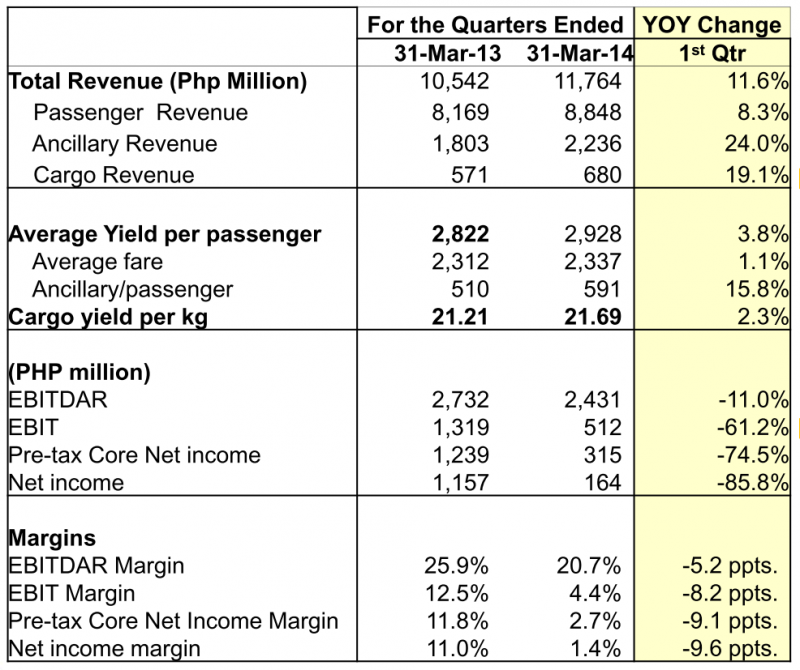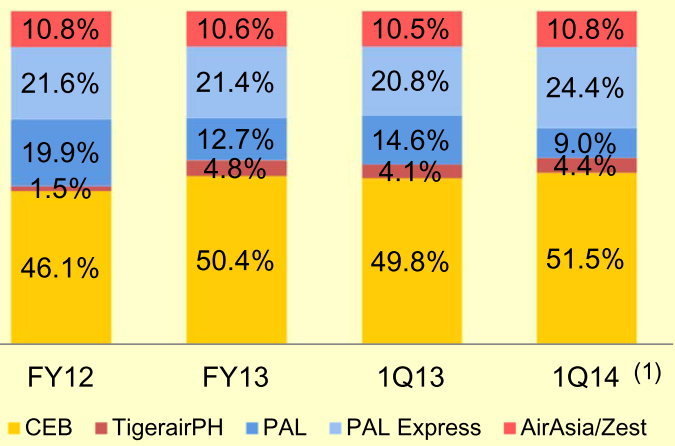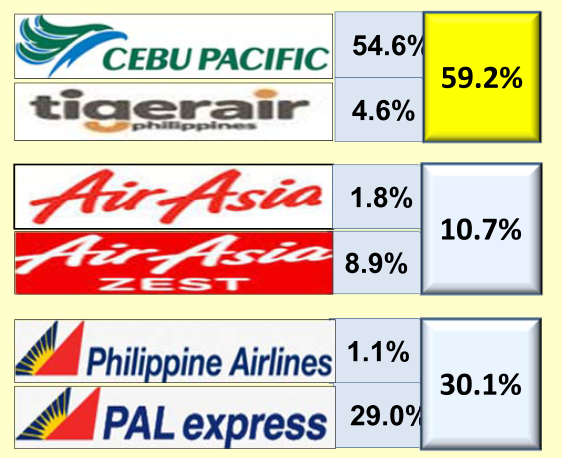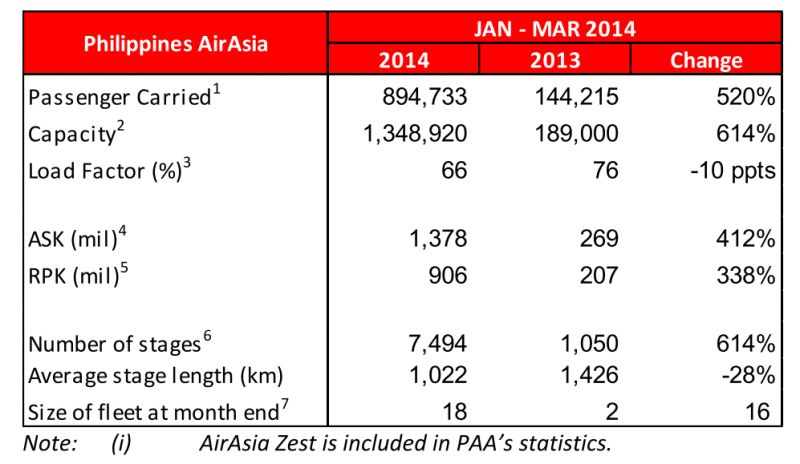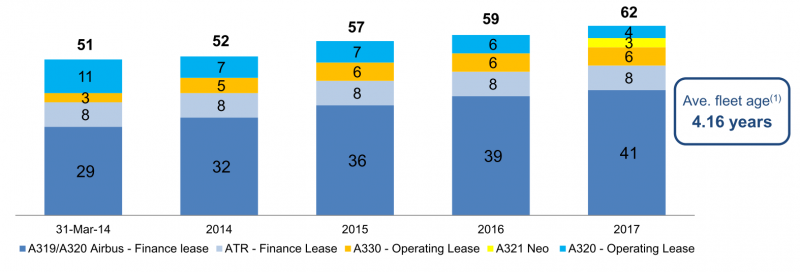Cebu Pacific Air profits drop; PAL, Philippines AirAsia remain in the red. But outlook is improving
The Philippines market has gone through unprecedented consolidation since the beginning of 2013 with three LCCs exiting, leaving one full-service and two low-cost players. But reduced competition and more rational domestic capacity levels has not yet led to an improvement in profitability. Cebu Pacific Air recorded a sharp drop in profits for 1Q2014 while Philippine Airlines (PAL) and Philippines AirAsia (PAA) again incurred large losses.
Cebu Pacific, which acquired much smaller low-cost competitor Tigerair Philippines in Mar-2014, has been impacted by losses at its new long-haul operation. PAL has been impacted by ambitious international expansion, including the resumption of services to Europe and the Middle East. PAA, which has been highly unprofitable since its 2012 launch, continues to struggle despite its merger with another Philippine LCC, Zest Air.
But the outlook for the Philippine market, particularly the LCC sector, is relatively bright compared to most other Southeast Asian markets as only the Philippines has seen significant consolidation.
The Philippines leads Southeast Asia with consolidation
Inevitably consolidation will spread throughout Southeast Asia given the current overcapacity, which drove drops in yield and profitability in 1Q2014 at virtually every publicly traded airline in the region. But the Philippines has a clear head start as the necessary consolidation has already taken place and therefore it stands to see an improvement in market conditions before other Southeast Asian countries.
Cebu Pacific is best positioned to benefit from the consolidation. Its already leading domestic share of the Philippine market has increased as a result of its acquisition of Tigerair Philippines and capacity cuts by the two remaining competitors, the AirAsia and the PAL groups.
Cebu's domestic yields are starting to show signs of improvement as capacity has finally returned to rational levels. Its new long-haul operation, which has incurred steep losses and contributed to most of Cebu's fall in profitability since the launch of Dubai services in Oct-2013, is also showing signs of improvement.
Cebu Pacific ekes out USD4 million profit for 1Q2014
Cebu Pacific saw its net profit narrow by 86% from PHP1.157 billion (USD28 million) in 1Q2013 to only PHP164 million (USD4 million) in 1Q2014. Revenues were up 12% but RPKs were up at a faster clip, 14%, against a 20% increase in ASKs as the carrier's load factor dropped 4.2ppts to 86.8%. Passenger figures were up by 7% to 3.8 million.
Cebu Pacific Air financial highlights: 1Q2014 vs 1Q2013
For the second consecutive quarter, profitability was dragged down by Cebu's new long-haul operation. Cebu Pacific reported a 63% load factor on Manila-Dubai for 1Q2014 against a break even load factor on the route of 83% to 84%. (In 4Q2013, Cebu Pacific swung to a loss as the Dubai route got off to a dismal start, including a 36% load factor in Oct-2013.)
But the Dubai route, which showed significant improvement in Apr/May-2014 with a load factor around the break even point, is not entirely to blame for the sharp drop in profits for 1Q2014. Cebu's executive team told analysts during its 1Q2014 results briefing on 20-May-2014 that short-haul international yields were down as a result of intensifying competition while domestic yields were relatively flat.
Overall yield and average fares were up year over year by 4% and 1% respectively, bucking the trend in the broader Southeast Asian airline sector. But this is misleading as Cebu Pacific was entirely a short-haul operator until Oct-2013, when its new long-haul unit launched a daily service to Dubai.
Cebu's average fare on Dubai-Singapore has been about PHP11,000 (USD245), significantly higher than its system-wide average of about PHP3,000 (USD67).
Domestic Philippine yields expected to increase in 2Q2014
But unlike other domestic markets in Southeast Asia, the short-term outlook in the Philippines is relatively bright. Cebu Pacific expects "significant progress" in domestic yields in 2Q2014 and 2H2014, with year over year increases of approximately 13% and 19%.
Some improvement in short-haul international yields is also expected in 2Q2014, driven by new flights to Japan which come with a higher yield relative to other routes. But the regional international market from the Philippines generally remains challenging given the intense competition and the capacity being added by competitors. This is in line with the rest of Asia and particularly Southeast Asia, where overcapacity has become a common problem.
The Philippine domestic market, however, has seen unprecedented consolidation, putting it in a league of its own in what is otherwise an extremely challenging Southeast Asian marketplace. Total domestic traffic in the Philippines was down by 1% in 2013 to 20.3 million, driven by cuts at PAL which recorded a 37% drop in domestic traffic to 2.6 million. As CAPA previously analysed, Cebu Pacific's share of the domestic market grew from 46% in 2012 to 50% in 2013 (based on Philippine CAB data).
See related report: Cebu Pacific reports a loss for 4Q2013 but strengthens its position in domestic Philippines market
PAL makes further domestic adjustments to the benefit of Cebu Pacific
The PAL Group further cut domestic capacity in Mar-2014, dropping all of its point to point routes bypassing Manila. Cebu Pacific says included in the PAL cuts were 11 routes from Cebu, the second largest city in the Philippines, which are now left as monopoly routes for Cebu Pacific. Cebu Pacific says total capacity in the Philippines domestic market was down by 1% in 1Q2014.
Cebu Pacific estimates its share of the domestic market reached 52% in 1Q2014. When also including Tigerair Philippines, Cebu's share reached 56% while the PAL Group share declined to about 33%. AirAsia's share was roughly flat at just under 11% (based on Cebu Pacific estimates as official Philippine CAB data is not yet available for 1Q2014.)
Philippine domestic market share: 2012 to 1Q2014
For Mar-2014 the Cebu Pacific Group share of the Philippine domestic market reached an estimated 59% as the PAL Group share dropped to an estimated 30%, including only 1% for PAL mainline and 29% for PAL Express.
This reflects the first month under PAL Group's revised domestic strategy which relies almost entirely on PAL Express to serve the domestic market.
Philippine domestic market share: Mar-2014
The PAL Group initially adjusted its domestic strategy in early 2013 as PAL Express, formerly known as AirPhil Express, transitioned from a pure LCC to more a full-service regional model. This followed PAL Express taking over most secondary domestic routes from PAL mainline while withdrawing from most trunk routes.
Under the previous PAL Group strategy, which had been implemented by the former ownership and management group, PAL and AirPhil overlapped on domestic trunk routes with AirPhil focusing on the bottom end of the market and PAL focusing on high end and connecting traffic. (PAL Express has a lower cost structure than PAL and still has some components of the LCC model, including operating aircraft in single-class configuration, but offers several frills including checked bags, drinks, snacks and newspapers.)
See related report: Philippine Airlines group faces challenging future after exiting budget carrier sector
The latest iteration of the PAL Group's evolving two-brand strategy saw PAL Express taking over from PAL on most trunk routes while dropping the point to point routes. PAL Express has also pulled out of the international market with the exception of the Manila-Abu Dhabi route, which was launched in Nov-2013 with A330-300s in all-economy configuration. (Keeping just one international route and operating only one widebody aircraft is not a logical move but could be driven by a desire to compete more effectively against Cebu Pacific at the budget end of the Philippines-UAE market.)
Philippines AirAsia restructuring also benefits Cebu Pacific
AirAsia is also now in the process of cutting domestic capacity as part of a network restructuring aimed at turning around its unprofitable Philippine operation. PAA incurred an operating loss of MYR25 million (USD8 million) in 1Q2014 compared to a loss of MYR20 million (USD6 million) in 1Q2013.
PAA reported passenger traffic of 900,000 in 1Q2014 but a seat load factor of only 66%.
Philippine AirAsia operating highlights: 1Q2014
PAA operating figures now include both PAA and sister carrier Zest AirAsia but the financial figures still only include PAA. The two carriers continue to operate under separate codes but have been working on integrating their operations.
See related reports:
- AirAsia seeks to turn around Philippines operation with new focus on Zest Air and Manila
- AirAsia Philippines and Zest Air outlook improves following tie-up, but challenges remain
PAA and Zest first agreed to an equity swap and quasi-merger in Mar-2013 but Zest did not adopt the AirAsia brand until late 2013. The AirAsia Group stated in its 1Q2014 results presentation on 20-May-2014 that it expects to secure within the next few weeks approval to fully consolidate PAA and Zest under the PAA brand.
The Malaysia-based group also stated that it is hopeful its Philippine operation, which has been highly unprofitably since PAA's 2012 launch, can finally be in the black from 2H2014. PAA and Zest have been working on rationalising their combined network and reducing costs. Yields are expected to improve after the network is restructured and new services to Korea and Japan are launched.
PAA will still have challenges as it does not have the scale or position of Cebu Pacific. But having to compete with only one local LCC rather than the five when it launched (Cebu Pacific, AirPhil, Zest, SEAir/Tigerair Philippines and Spirit of the Philippines) clearly improves its long-term prospects. PAA should be able to join Cebu Pacific in benefitting from an improvement in domestic yields while in the more competitive regional international market it should be able to leverage the strong pan-Asian position of the AirAsia brand.
Philippine Airlines incurs USD21 million loss in 1Q2014
The PAL Group outlook also improves as the overall market conditions in the Philippines become brighter and as it finally has been cleared to pursue expansion in the US, one of its largest markets. But it is not as bright as Cebu Pacific or PAA because PAL no longer has a play in the budget sector, which dominates the Philippine market as it is a highly price-sensitive market.
PAL Holdings reported a PHP931 million (USD21 million) net loss for 1Q2014 compared to a PHP1.256 billion (USD31 million) net loss for 1Q2013. Revenues were up 18% to PHP21.655 billion as the carrier rapidly expanded its international operation. Over the last year PAL has launched services to London, Dubai, Doha, Dammam and Riyadh while also pursuing capacity expansion on regional routes within Asia as 15 aircraft including nine widebodies were added to the fleet.
PAL should see some improvement in its trans-Pacific performance starting in 2Q2014 as 777-300ERs take over for inefficient 747-400s on Los Angeles and San Francisco. The 747-400s, which were kept several years past their intended expiration date for trans-Pacific routes because US FAA Category 2 restrictions precluded any change of gauge on the US routes, are being retired.
See related report: Cebu Pacific and Philippine Airlines are poised to expand in US following Category 1 upgrade
But PAL faces intense competition on its new routes to the Middle East and London. Japan, which is the carrier's largest market accounting for 24% of its international seat capacity, also has become more competitive as a new bilateral has enabled significant expansion from Cebu Pacific and the entrance of AirAsia. South Korea is its second largest market, accounting for 13% of international seat capacity, will also see new competition from AirAsia and has already seen more capacity from Cebu Pacific.
Domestically market conditions have improved. PAL Express should benefit from the domestic consolidation but PAL Express is not part of PAL Holdings. (Philippine conglomerate San Miguel is the largest shareholder in both PAL and PAL Express but the ownership structures are slightly different and only PAL is publicly traded albeit with a very small float.)
Cebu Pacific quickly turns around Tigerair Philippines
The outlook for PAL/PAL Express, PAA and Cebu Pacific have also all improved as a result of Tigerair's recent exit. The Singapore-based Tigerair Group had been an aggressive competitor on domestic Philippine trunk routes since it entered the market in mid-2012, contributing to the irrational fares and capacity levels.
Tigerair Philippines had been highly unprofitable under the Singapore-based Tigerair Group but Cebu Pacific is confident it can quickly turn around its new wholly owned subsidiary. (For now the carrier continues to be branded as Tigerair Philippines although it is entirely owned by Cebu Pacific.)
Cebu Pacific executives said during the 1Q2014 results briefing that Tigerair Philippines had suffered from revenue and cost problems. Revenues improved almost immediately after the acquisition closed on 20-Mar-2014, with average fares increasing by nearly 50%, as Cebu Pacific was able to move Tigerair Philippines under its own distribution network and website. As a result Tigerair Philippines was already in the black in Apr-2014.
Cebu Pacific expects further improvements in Tigerair Philippines' profitability as it is now focusing on further reducing the carrier's costs. Cebu Pacific estimates that Tigerair Philippines' cost structure was 25% higher than Cebu Pacific's cost structure prior to the sale. Cebu Pacific has already closed about half of this gap by improving aircraft utilisation levels at Tigerair Philippines and pursuing cost synergies.
Cebu Pacific has so far subleased one A320 to Tigerair Philippines, replacing two A319s which have been returned to Tigerair Group. Three more Cebu Pacific-owned A320s will be moved to Tigerair Philippines in 3Q2014, allowing Tigerair Philippines to further reduce asset costs as three A320s are returned to the Tigerair Group.
Cebu Pacific expects it will be able to close the remaining 12% to 13% cost gap with Tigerair Philippines by the end of 2Q2014, which should result in the subsidiary providing positive contributions from 3Q2014. Cebu Pacific particularly expects an improvement when it takes over the ground handling of Tigerair flights on 20-Jun-2014, replacing an external supplier. Cebu Pacific estimates Tigerair Philippine's ground handling costs will be reduced by 50% to 60% from 3Q2014.
With such high costs it is hardly surprising Tigerair Philippines struggled under the Tigerair Group, leading to the Singapore-based group deciding to dispose of its Philippine affiliate. The purchase of Tigerair Philippines is part of a wider partnership between Cebu Pacific and the Tigerair Group which will also see the two carriers interline.
See related report: Cebu Pacific becomes latest Tigerair partner. Can LCC alliances counterbalance AirAsia and Lion?
Cebu Pacific says Tigerair will start selling joint Tigerair/Cebu Pacific itineraries in Jul-2014 while Cebu Pacific expects to be able to start selling joint Cebu Pacific/Tigerair itineraries by Sep-2014. The itineraries will open up a wide array of LCC connections such as Singapore-Tokyo via Manila and Manila-Male via Singapore, boosting revenues and traffic volumes for both groups.
Tigerair Philippines currently operates 91 domestic flights. As a group Cebu Pacific now operates about 1,900 weekly domestic flights across 61 routes and 31 destinations.
Cebu Pacific accelerates its international expansion
Tigerair Philippines also has a small international operation. Cebu Pacific overall now has about 450 international weekly flights across 35 routes to 25 destinations.
Cebu Pacific accounted for 16.3% of passengers in the Philippine international market in 2013 while Tigerair Philippines accounted for 1.6%, giving the group an 18% share. The PAL Group captured a 24.6% share while PAA/AirAsia Zest accounted for a 4.8% share. Foreign carriers accounted for the remaining 52.7% share, according to Philippine CAB data. (International market data is not yet available for 1Q2014.)
The total international market in the Philippines grew by 3% in 2013 to 17.3 passengers. Cebu's international passenger traffic was also up 3% in 2013 to 2.9 million passengers (excludes Tigerair Philippines). Cebu's international passenger traffic was up slightly in 1Q2014 to 900,000 passengers. Faster growth is likely in 2Q2014 as expansion of the carrier's international network accelerated in Mar-2014 with the launch of flights from Manila to Bali, Nagoya and Tokyo Narita.
Further expansion to Japan, where Cebu Pacific previously only served Osaka, and long-haul expansion to the Middle East and Australia will be the focus for the remainder of 2014. Cebu Pacific also aims to launch services to Guam by the end of 2014 with Hawaii to potentially follow in 2015.
Opportunities for further short-haul international expansion are relatively limited because the carrier's A320 fleet will shrink over the last three quarters of 2014 as four aircraft are returned and three are delivered. Cebu Pacific is also moving another three aircraft to Tigerair Philippines in 3Q2014, leaving it with even fewer A320s for its mainline operation (although the group is keen to reduce unit costs by improving average utilisation levels).
However, its new widebody fleet continues to grow. Cebu Pacific took delivery of its third A330-300 in Feb-2014, its fourth aircraft on 16-May-2014 and is slated to receive its fifth aircraft in Aug-2014. The sixth and final A330-300 from its initial six aircraft commitment is slated to be delivered in 2015.
Cebu Pacific fleet plan: 2014 to 2017
Cebu Pacific is finally ready to announce more long-haul routes, starting with Saudi Arabia
Currently only one of Cebu's A330s is allocated to its long-haul operation. Cebu Pacific has been using two of its A330s to add capacity on regional international routes as well as on some domestic sectors. The A330 is currently used on some flights to Singapore, Seoul, Taipei and Davao. (It was also briefly used to Cebu and has been approved for Tokyo Narita, which was launched at the end of Mar-2014 and for now uses A320s.)
Cebu Pacific will finally start to allocate a second A330 to the long-haul market in Aug-2014, when it intends to launch services to Saudi Arabia with two destinations. Cebu Pacific executives told analysts that within the next few week plans will be finalised and ticket sales will begin for two Saudi Arabia destinations.
As CAPA previously reported, Cebu Pacific has been preparing to serve Riyadh and Dammam with four weekly non-stop flights to one destination and three weekly non-stop flights to the second destination.
See related report: Cebu Pacific's long-haul low cost 2014 expansion to Australia, Saudi Arabia, with Middle East focus
Cebu Pacific executives say the airline also now aims to launch services to Kuwait and Australia by the end of 2014. The carrier is already approved for Kuwait, as it is with Saudi Arabia. Cebu Pacific says it is in the final phase of the approval process with Australia's Civil Aviation Safety Authority, which should give Cebu Pacific the final go ahead within the next few weeks.
By the end of 2014 Cebu Pacific expects to be using four of its initial five A330-300s on five long-haul routes, while the fifth aircraft will continue to be used in the regional international market. Cebu Pacific's A330 service to Singapore has particularly been successful and will likely continue. Cebu Pacific executives say that the A330 on Manila-Davao has also worked well while Manila-Cebu was less successful as it is a shorter route.
Cebu Pacific's Honolulu launch requires extended ETOPS approval
Honolulu has also been added to the network plan for Cebu Pacific's long-haul operation now that the US FAA has upgraded Philippine regulatory authorities to a Category 1 safety rating. Cebu Pacific is now working through the process of securing US FAA authorisation to operate aircraft to the US. It aims to initially serve the US by operating A320s on Manila-Guam, which Cebu Pacific is now hoping to launch by the end of 2014 contingent on FAA approvals
Honolulu is likely to be launched in 2015, using the sixth A330. Cebu Pacific executives point out that Hawaii requires an extension of Cebu's ETOPS authority, which could take several months to secure, making a 2014 launch infeasible.
Cebu Pacific will compete against PAL on both the Manila-Honolulu and Manila-Guam routes as well as to Saudi Arabia and Australia. The prospect of a low-cost competitor on more international routes is not favourable for PAL's outlook but the flag carrier will continue to have a strong position in the mainland US market, where it is now looking to expand with potential new services to Chicago and New York.
PAL also will continue being the only Philippine carrier serving Europe for the foreseeable future because, while Cebu Pacific has been removed from the EU black list, it does not have aircraft with sufficient range to reach Western Europe or the mainland US. PAL now only serves London Heathrow but has been looking at several potential destinations in continental Europe.
Cebu Pacific has a relatively bright outlook but challenges remain
Cebu's outlook should improve as it diversifies its long-haul network to include Australia and eventually the US. The larger operation will also give Cebu Pacific more scale, resulting in a lower break even load factor.
The original plan for Cebu's long-haul unit relied almost entirely on the Philippines-Middle East market. But the market is highly seasonal and primarily consists of bookings made by labour contractors, making it challenging to stimulate sufficient demand on a year round basis.
See related report: Philippines-UAE market suffers from overcapacity, impacting Cebu Pacific, PAL, Emirates and Cathay
Cebu Pacific has improved its performance on Dubai considerably since Oct-2013, when its load factor was a dismal 36%, and has overcome an initial weakness with local sales. Initial bookings were impacted as Cebu Pacific resisted entering global distribution systems in a bid to preserve its pure LCC model.
Cebu Pacific executives are now glad they stayed true to their model as it has been able to educate the local market, resulting in much higher volume web bookings than initially. However, the 80% plus load factor from April and May is not expected to hold up in June through August due to the slower Ramadan period, even with the carrier temporarily reducing capacity from seven to five weekly flights.
With domestic market conditions now improved, Cebu Pacific needs to increase its focus on improving the long-term profitability of its international operation. As the carrier prepares to announce and begin ticket sales on four more long-haul routes it needs to make sure it has the marketing and distribution plan in place to avoid a repeat of the dismal start it had in Dubai.
The one route alone has been detrimental to Cebu's 4Q2013 and 1Q2014 performance, providing a hard lesson as Cebu Pacific works out the kinks of long-haul operations.
But Cebu Pacific has a lot to look forward to as it becomes the first LCC to enter several markets including Philippines to Australia, Kuwait, Saudi Arabia and the US. It is also now the only LCC serving the large Manila-Tokyo and Manila-Nagoya routes. Cebu Pacific should be able to stimulate demand across all these markets while enjoying the fruits of its leading position in the much improved Philippine domestic market.
